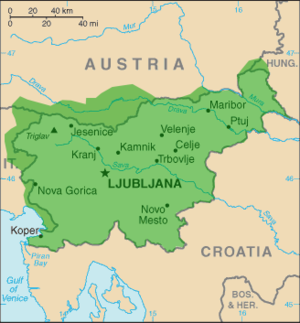Languages of Slovenia
[7] Other significant languages are Croatian and its variants and Serbian, spoken by most immigrants from other countries of former Yugoslavia and their descendants.
Italian and Hungarian language, protected by the Constitution of Slovenia, had lower numbers of native speakers.
[9][10] In its Article 11, the Constitution of Slovenia stipulates that Slovene is to be the sole official and national language throughout the country.
Publishing or broadcasting untranslated material, as well as selling goods without instructions and declaration in Slovene, is punishable and banned by law.
After having passed the exam, the applicant receives the certificate of knowledge of the Slovene language, issued by the Faculty of Arts of University of Ljubljana, which is valid throughout the European Union, and makes the holder eligible to apply to any school or university in Slovenia.
Additionally, Slovenian citizens may write to any EU institution in Slovene and expect a response in the same language.
[clarification needed][14] It has a limited standardized written form,[15] has been used in the liturgy,[16][17] and has been used in modern literature, music, television and film.
Hungarian is co-official with Slovene in 30 settlements in 5 municipalities (whereof 3 are officially bilingual): A significant number of Slovenian population speak a variant of Croatian and Serbian as their native language.
In four villages (Miliči, Bojanci, Marindol and Paunoviči), people speak the Eastern Herzegovinian dialect, with a strong influence of Slovene.
[23] German and Bavarian dialects have been autochthonous since present-day Slovenia came under the rule of Bavaria in the 8th century.
Until the 20th century, the most numerous German-speaking communities were found in the urban centers of Lower Styria, in the Gottschee County in southern Slovenia and in the villages around Apače (Apaško polje) along the Mura river.
After World War I, the number of German-speakers dropped significantly: most of the towns were slovenized, and German remained the majority language only in the Gottschee County and around Apače.
During World War II, ethnic Germans were resettled from areas occupied by Italy (Ljubljana, Gottschee) into the German-occupied zone.
On the end and after the war, the great majority of the remaining Germans were expropriated (AVNOJ-Decree), expulsed or murdered by Yugoslav partisans.
[20] Historically, German was the lingua franca of Central European space and was perceived as the language of commerce, science and literature in Slovenia.
According to Eurostat, Slovenia has the highest competence in German of any non-Germanic country, with only Luxembourg, the Netherlands, and Denmark being higher.


